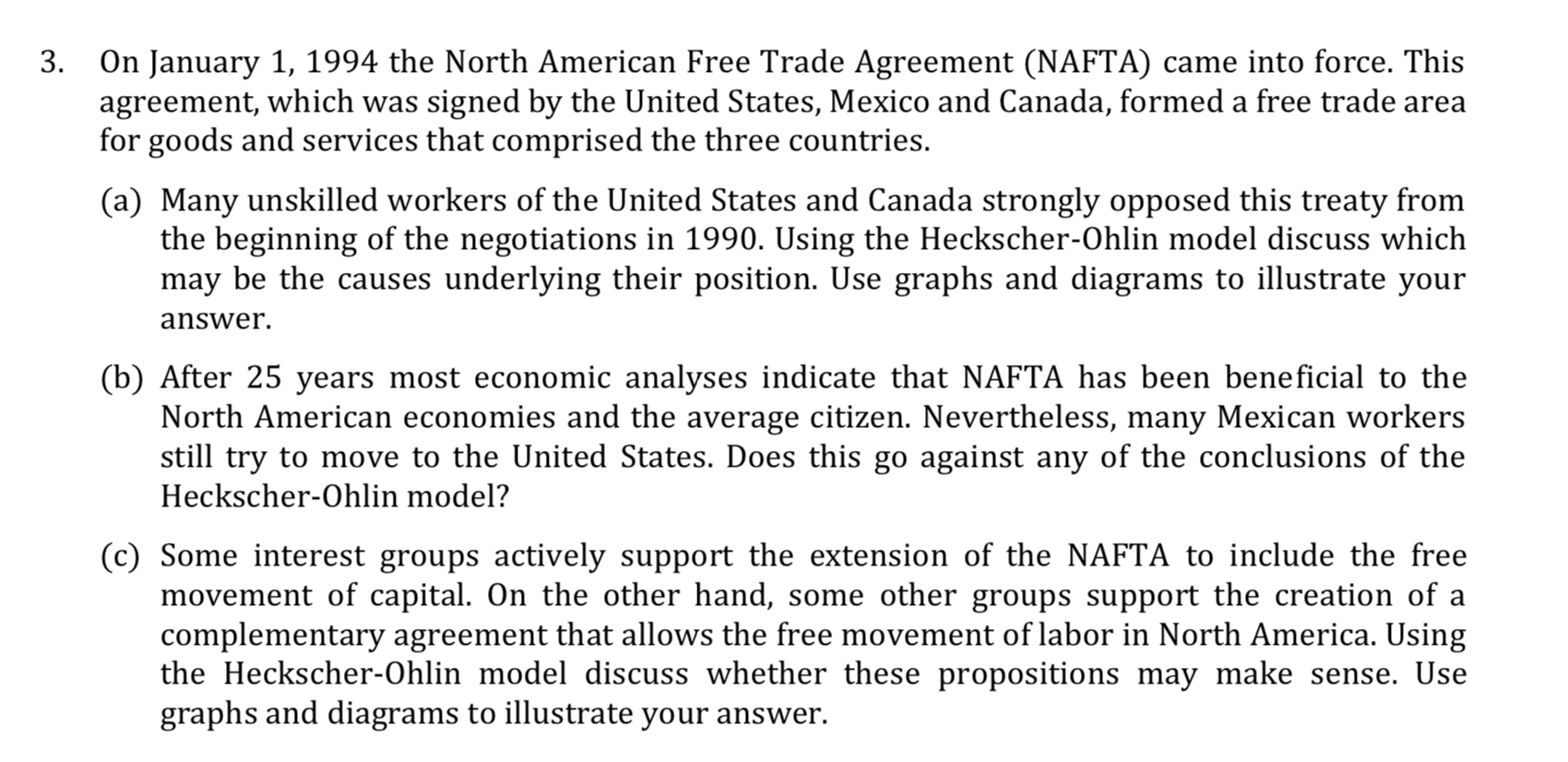3. On January 1, 1994 the North American Free Trade Agreement (NAFTA) came into force. This agreement, which was signed by the United States, Mexico and Canada, formed a free trade area for goods and services that comprised the three countries. (a) Many unskilled workers of the United States and Canada strongly opposed this treaty from the beginning of the negotiations in 1990. Using the Heckscher-Ohlin model discuss which may be the causes underlying their position. Use graphs and diagrams to illustrate your answer. (b) After 25 years most economic analyses indicate that NAFTA has been beneficial to the North American economies and the average citizen. Nevertheless, many Mexican workers still try to move to the United States. Does this go against any of the conclusions of the Heckscher-Ohlin model? (c) Some interest groups actively support the extension of the NAFTA to include the free movement of capital. On the other hand, some other groups support the creation of a complementary agreement that allows the free movement of labor in North America. Using the Heckscher-Ohlin model discuss whether these propositions may make sense. Use graphs and diagrams to illustrate your answer.
3. On January 1, 1994 the North American Free Trade Agreement (NAFTA) came into force. This agreement, which was signed by the United States, Mexico and Canada, formed a free trade area for goods and services that comprised the three countries. (a) Many unskilled workers of the United States and Canada strongly opposed this treaty from the beginning of the negotiations in 1990. Using the Heckscher-Ohlin model discuss which may be the causes underlying their position. Use graphs and diagrams to illustrate your answer. (b) After 25 years most economic analyses indicate that NAFTA has been beneficial to the North American economies and the average citizen. Nevertheless, many Mexican workers still try to move to the United States. Does this go against any of the conclusions of the Heckscher-Ohlin model? (c) Some interest groups actively support the extension of the NAFTA to include the free movement of capital. On the other hand, some other groups support the creation of a complementary agreement that allows the free movement of labor in North America. Using the Heckscher-Ohlin model discuss whether these propositions may make sense. Use graphs and diagrams to illustrate your answer.
Chapter18: International Trade And Comparative Advantage
Section: Chapter Questions
Problem 2TY
Related questions
Question

Transcribed Image Text:3. On January 1, 1994 the North American Free Trade Agreement (NAFTA) came into force. This
agreement, which was signed by the United States, Mexico and Canada, formed a free trade area
for goods and services that comprised the three countries.
(a) Many unskilled workers of the United States and Canada strongly opposed this treaty from
the beginning of the negotiations in 1990. Using the Heckscher-Ohlin model discuss which
may be the causes underlying their position. Use graphs and diagrams to illustrate your
answer.
(b) After 25 years most economic analyses indicate that NAFTA has been beneficial to the
North American economies and the average citizen. Nevertheless, many Mexican workers
still try to move to the United States. Does this go against any of the conclusions of the
Heckscher-Ohlin model?
(c) Some interest groups actively support the extension of the NAFTA to include the free
movement of capital. On the other hand, some other groups support the creation of a
complementary agreement that allows the free movement of labor in North America. Using
the Heckscher-Ohlin model discuss whether these propositions may make sense. Use
graphs and diagrams to illustrate your answer.
Expert Solution
This question has been solved!
Explore an expertly crafted, step-by-step solution for a thorough understanding of key concepts.
Step by step
Solved in 3 steps with 1 images

Recommended textbooks for you


Microeconomics: Principles & Policy
Economics
ISBN:
9781337794992
Author:
William J. Baumol, Alan S. Blinder, John L. Solow
Publisher:
Cengage Learning

Principles of Macroeconomics (MindTap Course List)
Economics
ISBN:
9781305971509
Author:
N. Gregory Mankiw
Publisher:
Cengage Learning


Microeconomics: Principles & Policy
Economics
ISBN:
9781337794992
Author:
William J. Baumol, Alan S. Blinder, John L. Solow
Publisher:
Cengage Learning

Principles of Macroeconomics (MindTap Course List)
Economics
ISBN:
9781305971509
Author:
N. Gregory Mankiw
Publisher:
Cengage Learning

Brief Principles of Macroeconomics (MindTap Cours…
Economics
ISBN:
9781337091985
Author:
N. Gregory Mankiw
Publisher:
Cengage Learning

Principles of Macroeconomics (MindTap Course List)
Economics
ISBN:
9781285165912
Author:
N. Gregory Mankiw
Publisher:
Cengage Learning

Principles of Economics, 7th Edition (MindTap Cou…
Economics
ISBN:
9781285165875
Author:
N. Gregory Mankiw
Publisher:
Cengage Learning